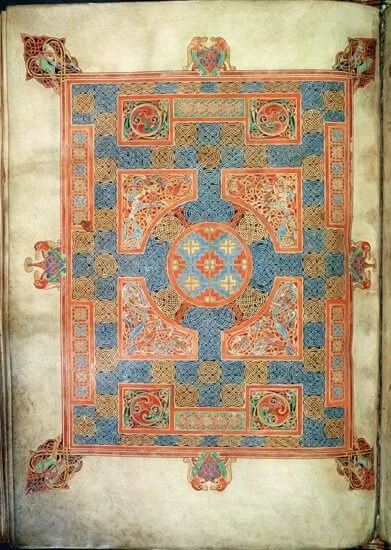The Lindisfarne Gospels: the outstanding achievement of early medieval western art
The Lindisfarne Gospels




The Lindisfarne Gospels must be the outstanding artistic creation of the early Middle Ages with their breathtaking colours and the innumerable detailed ornamental decoration. The text uses 45 colours and tones: including intricate spirals, beautiful whorls, and fantastic bird and animal forms worked into the designs resulting in a spectacular carpet of interwoven colours. Oversized ornamented initials with an unbelievable wealth of motifs open each Gospel, and are accompanied by full length portraits of the Evangelists writing down the Word of God. The detail is so rich, that the eyes of the evangelists have an almost hypnotic quality.
The Lindisfarne Gospels represent a culmination of Anglo-Saxon, Celtic, Germanic, Roman and Byzantine styles and are highly regarded by palaeographers, art historians, linguists and collectors alike.
The Lindisfarne Gospels contain the first version of the Gospels in English.
What makes it the more extraordinary is that it was scribed, illustrated and illuminated by one man in the five years preceding his death (probably 715-720 A.D.).
In addition to his talents, so clearly demonstrated throughout the Gospels, Bishop Eadfrith of Lindisfarne was a technical innovator, a skilled chemist and, possibly, the inventor of the pencil and the light-box. We learn something about him from Aldred, a member of the community of St Cuthbert, who inserted the English translation between the lines of the Latin text some 240 years after the creation of the original text.
Many myths surround The Lindisfarne Gospels but it was most certainly true that the document was often removed from Lindisfarne, or the Holy Isle, to avoid Viking and other raids. The original manuscript is now displayed in the British Library with one double-page exposed to view at any time.
The fine art facsimile Edition of The Lindisfarne Gospels is published by Faksimile Verlag Luzern (the fine art facsimile publishers of Switzerland) in association with the British Library.
The Gospels are carefully and beautifully hand-bound in a high quality leather cover, in keeping with craft book binding traditions, and is limited to 980 copies worldwide.
An alternative version of The Lindisfarne Gospels (limited to 290 copies) reproduces the more elaborate and ornate binding originally instigated in 1853 by Edward Maltby, Bishop of Durham.
This uses a silver frame, coloured stones, tin and silver based alloys, and a spine richly embroidered in gold thread.
Both versions are accompanied by a commentary from Dr Michelle P. Brown, Curator of Illuminated Western Manuscripts at The British Library. This covers all aspects of the manuscript, its production and meaning. It also places The Lindisfarne Gospels in the broader context of Insular art. You can request more information by using the forms below or emailing susan.barnes@addisonpublications.com
Get in touch
If you would like to like to reserve a copy or request a viewing of The Lindisfarne Gospels, or if you would simply like to know more, you can call Addison Publications on +44 (0) 20 7602 1848 or email susan.barnes@addisonpublications.com or fill in the form below and we will be delighted to contact you.




